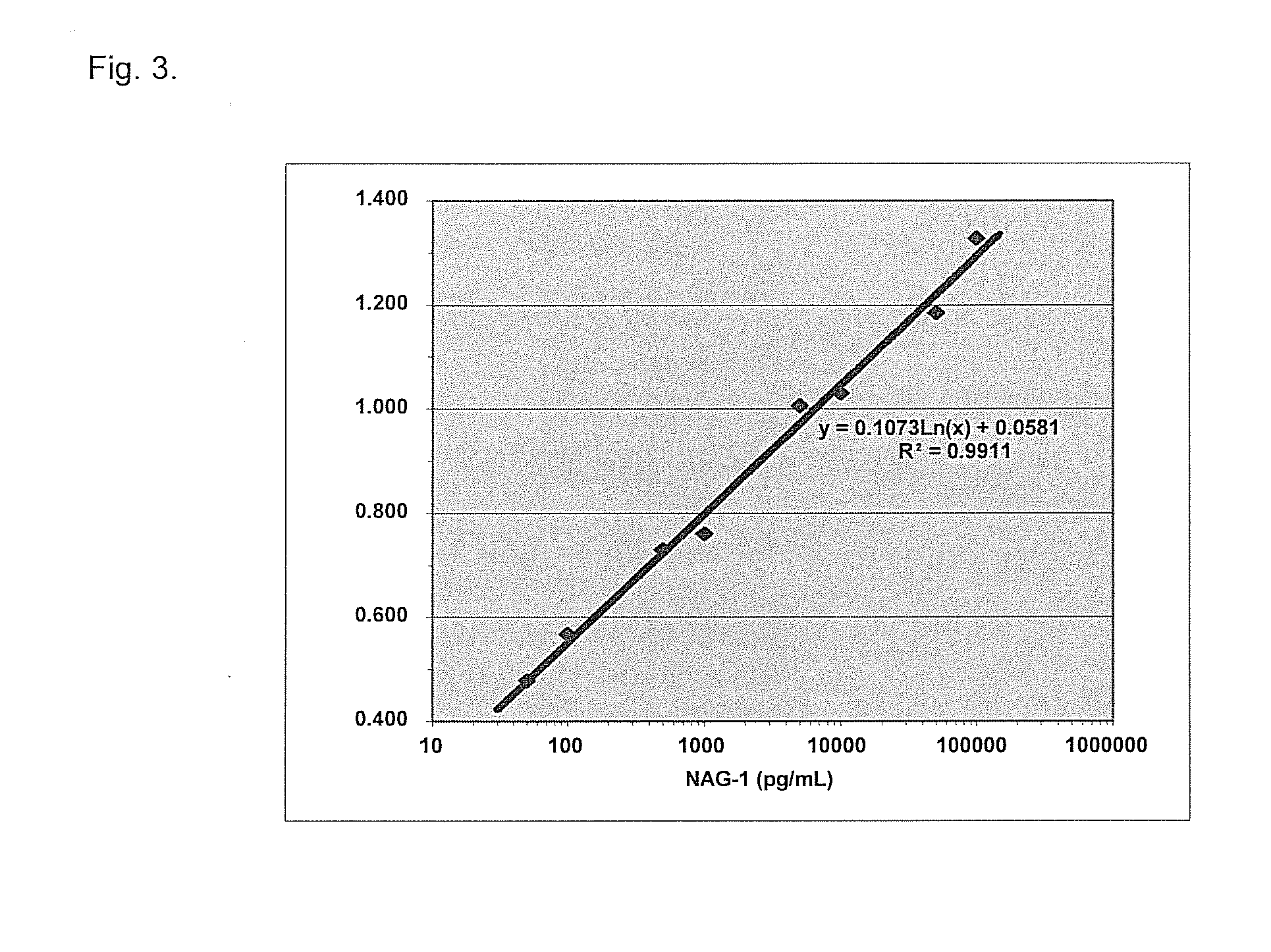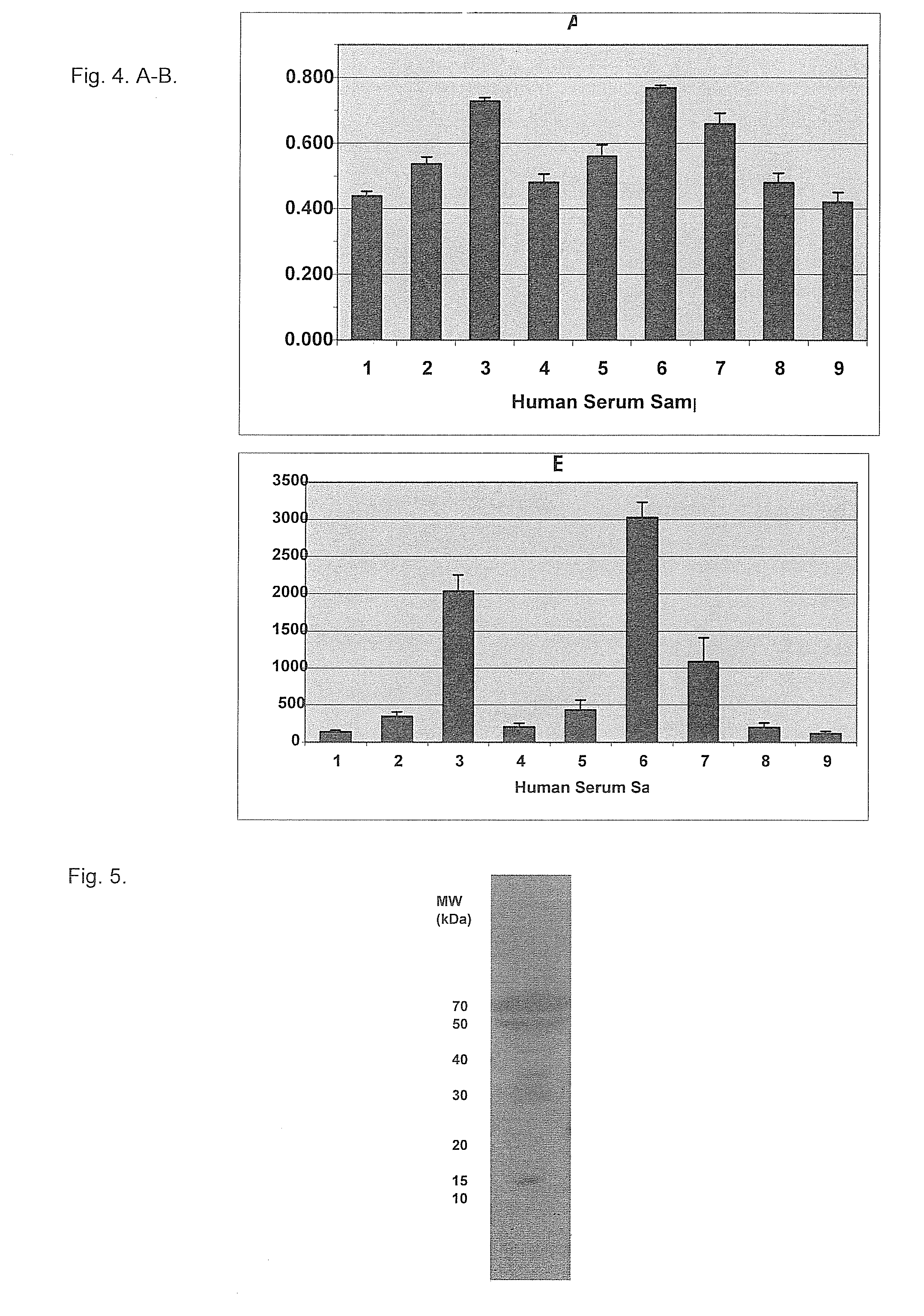Form-specific antibodies for nag-1 (mic-1, gdf-15), h6d and other tgf-beta subfamily and heart disease and cancer diagnoses
a technology of form-specific antibodies and tgf, which is applied in the field of methods to achieve the effect of preventing the formation of tgf-beta subfamily antibodies
- Summary
- Abstract
- Description
- Claims
- Application Information
AI Technical Summary
Problems solved by technology
Method used
Image
Examples
example 1
[0086]Form-Specific Antigen Peptide Design and KLH Conjugation
[0087]The approach was to design peptides, CRNGDD (SEQ ID NO: 2) and CRNGDH (SEQ ID NO: 1), which contain N-terminal Cys to allow peptide conjugation with KLH in a specific orientation. By this method, H6 or D6 at the C-terminus of the peptide protruded to the solution and was recognized as an epitope during antibody production. Successful form-specific antibodies produced for NAG-1 and H6D proteins using this strategy were a surprise. CRNGDH (Peptide 1, SEQ ID NO: 1) and CRNGDD (Peptide 2, SEQ ID NO: 2) peptides were obtained from Invitrogen and the peptides were conjugated with KLH, BSA and ovalbumin (OVA) via the sulfhydryl side chain of Cys. The peptides conjugated with BSA or OVA were used for an antibody titer measurement and assessment of specificity.
example 2
[0088]Form-Specific Wild Type NAG-1 and H6D Polyclonal Antibody Production and Characterization of Specificity
[0089]Polyclonal antibodies for wild type NAG-1 and H6D proteins were produced at AnaSpec by immunization of two rabbits for each peptide antigen. Titers of the NAG-1 and H6D anti-peptide antibodies were measured with 5,000- through 3,500,000-fold diluted pre-immune sera and first bleed sera obtained after the 2nd immunization using ELISA plates coated with NAG-1 or H6D peptide-conjugated BSA.
[0090]Whereas pre-immune sera showed almost no cross-reactivity (optical density at 450 nm: 0.01-0.04) with NAG-1 or H6D antigen peptide-conjugated BSA, immune sera showed very high cross-reactivity (optical density at 450 nm: 1.3 and 1.2 for two NAG-1 rabbit sera and 2.2 and 1.3 for two H6D rabbit sera with 5,000-fold dilution). This result showed that antibody titers were exceptionally high, especially considering that the bleed used was only after the 2nd immunization.
[0091]The secon...
example 3
[0095]Wild Type NAG-1- or H6D-Specific Monoclonal Antibody Production
[0096]Peptide 1 for the wild type (CRNGDH, SEQ ID NO: 1) and Peptide 2 for H6D (CRNGDD, SEQ ID NO: 2) were conjugated to KLH via sulfhydryl side chain of N-terminal Cys of the peptides. Five mice were immunized at Open Biosystems with each peptide-KLH conjugate for monoclonal antibody production.
[0097](a) Wild type NAG-1 antibody: Cross-reactivities of Mice #1 and #2 bleeds with Peptide 1-conjugated BSA were detected by ELISA (titers of 62,500 and 2,500, respectively). After a final immunization, Mice #1 and #2 were sacrificed and their spleen cells were fused with myeloma cells for hybridoma production.
[0098]ELISAs for supernatants (12 from Mouse #1 and 3 from Mouse #2) obtained from NAG-1 (anti-Peptide 1) hybridoma cell culture were carried out with a plate coated with Peptide 1- and Peptide 2-conjugated OVA. Clones with an optical density (OD) at 450 nm higher than 0.4 (background OD) were selected and are shown...
PUM
| Property | Measurement | Unit |
|---|---|---|
| pH | aaaaa | aaaaa |
| pH | aaaaa | aaaaa |
| optical density | aaaaa | aaaaa |
Abstract
Description
Claims
Application Information
 Login to View More
Login to View More - R&D
- Intellectual Property
- Life Sciences
- Materials
- Tech Scout
- Unparalleled Data Quality
- Higher Quality Content
- 60% Fewer Hallucinations
Browse by: Latest US Patents, China's latest patents, Technical Efficacy Thesaurus, Application Domain, Technology Topic, Popular Technical Reports.
© 2025 PatSnap. All rights reserved.Legal|Privacy policy|Modern Slavery Act Transparency Statement|Sitemap|About US| Contact US: help@patsnap.com



